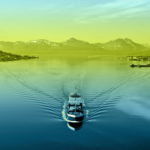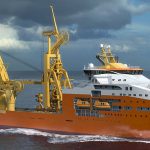At the 50th anniversary Nor-Shipping welcomes the industry to a global maritime hot spot. Norway has become more relevant for the industry than ever, the event shows. By Sverre Gutschmidt
At one of the leading maritime events Nor-Shipping, which takes place in the Norwegian capital Oslo June 2-5, maritime[ds_preview] players from all over the globe have reason to celebrate »50 years looking forward«, which will be the motto of the three hour opening conference.
At the trade fair »Innovation & Investment« will be in focus. About 16,300 external visitors, 8,000 exhibitor representatives and an additional 10,000 who participate in social events and meetings like the »Ocean Talent Camp« will gather. In 1965 the trade show opened its gates for the first time. Today it is hosted by a nation more relevant to shipping and globalized trade than ever. Today the maritime activities constitute more than 50% of Norwegian exports a recent study reveals. Excluding petroleum products it is still 38% (in 2013). In 2011 the Norwegian maritime cluster generated 211 bill. NOK (then 27 bill. €) turnover. The country’s maritime sector creates more value per employee than Norway’s average, proving its high efficiency.
The development of oil and gas and highly specialized maritime suppliers, builders and shipping has compensated for less Norwegian seaman and decreasing freight rates over the last decades. The concentration of maritime activities attracts global maritime business. According to the nation’s Global Centre of Expertise (GCE), »most of Norway’s strength in the field of advanced marine operations« is concentrated at Norway’s west coast. There over 220 leading maritime companies and training, research and finance institutions are located. This complete maritime cluster is hardly equaled by any other, a success which has made the conference one of the largest in shipping.
Technology and value creation
The impetus of innovation reflected by the program is backed by the countries latest maritime figures. This spring Norwegian Shipowner’s Association issued 126-page strategy paper »Navigating in a new climate – maritime outlook 2015« which sums up Norway’s increasingly important role: »The last ten years have seen the Norwegian foreign-going fleet grow by more than 150 ships.« In general, Norwegian ships are younger on average than global competitors’ vessels. In total Norway controls over 5% of the world’s merchant fleet.
The country’s leading position is echoed by an order book worth 93 bill. NOK (11,1 bill. €) with 176 vessels, half of them will be operational in 2017. Ties with China and South Korea are tight as both are most important shipbuilders for Norwegian owners.
At the same time, the paper presents expertise in some of shipping’s most relevant future markets. The offshore fleet which has the largest share in Norwegian owned and controlled vessels has grown by around 80% alone within the last ten years. Most modern offshore units are thus under Norwegian control. The country steers the second largest offshore fleet in the world, after the United States (USA).
In the other maritime business areas car carriers, LNG, chemical, and shuttle tankers the Norwegian position has strengthened, too. In contrast to a decreasing role as flag state which has diminished by 25% in ten years, the Norwegian operated or partly owned merchant fleet has grown by about 50% during the same period. So expansion and specialization form the fabric of Norway‘s maritime success on display in Oslo.
Green expansion
The leading role is closely linked to ecological development. The Norwegian joint effort to ensure green coastal shipping announced in January is another piece in the high-tech puzzle.
It resulted in a declaration of cooperation with key players in the Norwegian coastal shipping industry. Acting as vanguard in Green Shipping, Norway relies on the grown maritime wealth created so far. The country embraces LNG technology. Wealth and technological leadership inspire expansion. In September Siem Industries bought Flensburger Schiffbau-Gesellschaft (FSG).
According to FSG it is the Norwegians‘ strength in offshore which raises hopes for expansion as the shipyard wants
to take root in this market. The recent merger of Norwegian classification specialist DNV with German GL resulted in
the world’s largest classification society DNV GL.
Norway‘s role in ship finance
The 17th Annual Norway Ship & Offshore Finance Forum held as part of Nor-Shipping reflects Oslo’s role as an attractive market place in ship finance on a global scale.
Recent business activities have contributed to this reputation. Andreas Sohmen-Pao, Group Chief Executive Officer (CEO) and Managing Director at BW Maritime, is said to use Oslo Stock Exchange for the project of forming the group‘s products tanker division BW Pacific. According to media reports Oslo headquartered ABG Sundal is among the financing banks.
The bank also backed the world‘s largest very large gas carrier operator BW LPG when the company was listed in Oslo in 2013. BW LPG owns and operates 37 gas carriers with a total carrying capacity of close to 3mill. m3 and a further 756,000m3 of capacity on order in Korea. BW Pacific, however, saw a rapid growth in fleet size in 2014 and has more than 40 products tankers. Liquidity for global fleet expansion programs is thus arranged in Norway.
Yards: more orders from abroad
The backbone of the Norwegian shipbuilding industry is the Offshore Service Vessels (OSV) sector. Though Norwegian shipowners represent a significant share of the order book at Norwegian shipyards, half of the OSV newbuildings contracted at Norwegian yards in 2014 are foreign orders.
This trend is new. Value creation in coastal communities is thus not only relying on national orders but becoming more dependent on foreign orders. The Norwegian Export Credit Finance Agency (GIEK) and Export Credit Norway are powerful instruments to ensure orders. The peak years 2008 and 2009 when more than 50 of these OSV were built and/or outfitted at Norwegian shipyards are over, however.
Last year 35 newbuildings of this kind were completed. The prospering fish farm markets led to four new live fish carriers and two fish fodder vessels to be delivered in 2014. Fast Passenger Catamarans doubled to seven units in 2014 compared with 2013. Work boats have decreased from
31 (2013) to 28 in 2014. Havyard and Ulstein yards acquired orders from abroad, also Vard Aukra and Simek. All this contributes to the estimation, that Norway‘s shipbuilders have become more competitive.
This year‘s program
The programme of the biennial event will look beyond shipping magnates and invite experts who envisage globalization as a whole this year. On the maritime expert level most exhibitors are from shipbuilding and repair, followed by propulsion and machinery, maritime services and logistics. IT and navigation also play an important role and safety and rescue. The event starts at 9 a.m. with the »Ocean Talent Camp« at City Hall Square, Oslo. The exhibition which is at the heart of Nor-Shipping opens on the second day. It showcases around 22,500m2 of the best and latest in maritime technology.
The new initiative »Ocean Industry Podium« offers a series of one-hour sessions on finance, law & insurance and technology. Business in the High North will be discussed at the Arctic Business Council at 14 pm. Later that day start-ups give advice at the »Young@Nor-Shipping« seminar. The third day will feature the Agenda Offshore Conference and a Plenary Session on Brazil, as well as receptions by international key industry players.
On the fourth day, the 5th LNG Shipping Forum will cover new LNG markets, forecasts and financing. The youth will be in focus at the Young Politician debate and simultaneous 10th Anniversary of YoungShip. The last day, Friday, is reserved to the exhibition.
Sverre Gutschmidt






















